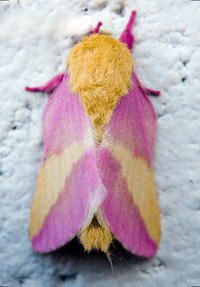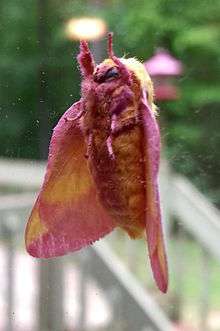Dryocampa rubicunda
| Rosy maple moth | |
|---|---|
 | |
| Scientific classification | |
| Kingdom: | Animalia |
| Phylum: | Arthropoda |
| Class: | Insecta |
| Order: | Lepidoptera |
| Family: | Saturniidae |
| Genus: | Dryocampa |
| Species: | D. rubicunda |
| Binomial name | |
| Dryocampa rubicunda (Fabricius, 1793)[1] | |
Dryocampa rubicunda (rosy maple moth) is a North American moth in the family Saturniidae. Males have a wingspan of 1.25 to 1.75 inches; females of 1.50 to 2 inches. They have reddish-to-pink legs and antennae, yellow bodies and hindwings, and pink forewings with a triangular yellow band across the middle. Males have bushier antennae than females. As the name implies, rosy maple moth caterpillars mainly feed on maples, particularly red maple, silver maple, and sugar maple. However, the adult moths do not eat, like all other Saturniid moths.[2]
Life cycle

Females lay pale yellow eggs in clusters of 20-30 on the undersides of maple leaves. After about two weeks, small gregarious caterpillars hatch. They will remain gregarious through the third instar, but the final two are solitary. The mature larvae are light green with black lateral lines, red heads, and two filaments behind the head, and reach lengths of about 2 inches. When they are ready, they [climb] crawl to the bottom of the host tree and pupate in shallow underground chambers. The pupae are very dark, elongated, and have small spines. The pupa ends in a small forked point. When the imago (adult) ecloses, it has small wings which it has to pump full of fluid in order for them to expand and allow for flight. Adult moths are generally nocturnal; they preferentially fly throughout the first third of the night.[3] The females emit pheromones at night and attract males, which have bushier antennae to detect the pheromones.
References
| Wikimedia Commons has media related to Dryocampa rubicunda. |
- ↑ Fabricius, Johan Christian (1793). "Bombyx". Entomologia systematica emendata et aucta. Vol 3. Part 1. Copenhagen: C. G. Proft, Fil. et Soc. p. 429.
- ↑ "Attributes of Dryocampa rubicunda". Butterflies and Moths of North America. Retrieved 28 April 2014.
- ↑ Fullard, James H.; Napoleone, Nadia (2001). "Diel flight periodicity and the evolution of auditory defences in the Macrolepidoptera" (PDF). Animal Behaviour. 62 (2): 349–368. doi:10.1006/anbe.2001.1753. Archived from the original (PDF) on 15 June 2007.